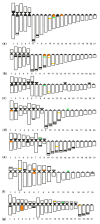Chromosome Mapping of 5S Ribosomal Genes in Indo-Pacific and Atlantic Muraenidae: Comparative Analysis by Dual Colour Fluorescence In Situ Hybridisation
- PMID: 33172170
- PMCID: PMC7694744
- DOI: 10.3390/genes11111319
Chromosome Mapping of 5S Ribosomal Genes in Indo-Pacific and Atlantic Muraenidae: Comparative Analysis by Dual Colour Fluorescence In Situ Hybridisation
Abstract
The Muraenidae is one of the largest and most complex anguilliform families. Despite their abundance and important ecological roles, morays are little studied, especially cytogenetically, and both their phylogenetic relationships and the taxonomy of their genera are controversial. With the aim of extending the karyology of this fish group, the chromosomal mapping of the 5S ribosomal gene family was performed on seven species belonging to the genera Muraena and Gymnothorax from both the Atlantic and Pacific oceans. Fluorescence in situ hybridisation (FISH) experiments were realized using species-specific 5S rDNA probes; in addition, two-colour FISH was performed to investigate the possible association with the 45S ribosomal gene family. Multiple 5S rDNA clusters, located either in species-specific or in possibly homoeologous chromosomes, were found. Either a syntenic or different chromosomal location of the two ribosomal genes was detected. Our results revealed variability in the number and location of 5S rDNA clusters and confirmed a substantial conservation of the number and location of the 45S rDNA.
Keywords: FISH; Gymnothorax; Muraena; Muraenidae; comparative cytogenetics; ribosomal genes.
Conflict of interest statement
The authors declare no conflict of interest.
Figures



Similar articles
-
Comparative chromosomal localization of 45S and 5S rDNAs and implications for genome evolution in Cucumis.Genome. 2016 Jul;59(7):449-57. doi: 10.1139/gen-2015-0207. Epub 2016 May 11. Genome. 2016. PMID: 27334092
-
Comparative cytogenetics of six Indo-Pacific moray eels (Anguilliformes: Muraenidae) by chromosomal banding and fluorescence in situ hybridization.J Fish Biol. 2015 Sep;87(3):634-45. doi: 10.1111/jfb.12737. Epub 2015 Aug 4. J Fish Biol. 2015. PMID: 26242690
-
Fluorescence in situ Hybridization Analysis of Oligonucleotide 5S Ribosomal DNA, 45S Ribosomal DNA, and (TTTAGGG)3 Locations in Gloriosa superba L.Cytogenet Genome Res. 2024;164(5-6):276-283. doi: 10.1159/000541706. Epub 2024 Oct 12. Cytogenet Genome Res. 2024. PMID: 39396512 Free PMC article.
-
Evolutionary dynamics of 5S rDNA location in acridid grasshoppers and its relationship with H3 histone gene and 45S rDNA location.Genetica. 2011 Jul;139(7):921-31. doi: 10.1007/s10709-011-9596-7. Epub 2011 Jul 14. Genetica. 2011. PMID: 21755328
-
Structure and Evolution of Ribosomal Genes of Insect Chromosomes.Insects. 2024 Aug 4;15(8):593. doi: 10.3390/insects15080593. Insects. 2024. PMID: 39194798 Free PMC article. Review.
Cited by
-
Karyotype Description and Comparative Chromosomal Mapping of 5S rDNA in 42 Species.Genes (Basel). 2024 May 20;15(5):647. doi: 10.3390/genes15050647. Genes (Basel). 2024. PMID: 38790276 Free PMC article.
-
Fish Cytogenetics: Present and Future.Genes (Basel). 2021 Jun 28;12(7):983. doi: 10.3390/genes12070983. Genes (Basel). 2021. PMID: 34203124 Free PMC article.
References
-
- Chen J.N., Samadi S., Chen W.J. Elopomorpha (Teleostei) as a New Model Fish Group for Evolutionary Biology and Comparative Genomics. In: Pontarotti P., editor. Evolutionary Biology: Biodiversification from Genotype to Phenotype. Springer; Cham, Switzerland: 2015. pp. 329–344. - DOI
-
- Fricke R., Eschmeyer W.N., Fong J.D. Eschmeyer’s Catalog of Fishes: Species by Family/Subfamily. [(accessed on 20 August 2020)]; Available online: http://researcharchive.calacademy.org/research/ichthyology/catalog/Speci....
-
- Wiley E.O., Johnson G.D. A teleost classification based on monophyletic groups. In: Nelson J.S., Schultze H.-P., Wilson M.V.H., editors. Origin and Phylogenetic Interrelationships of Teleosts. Verlag Dr. Friedrich Pfeil; Munchen, Germany: 2010. pp. 123–182.
MeSH terms
Substances
LinkOut - more resources
Full Text Sources
Research Materials

